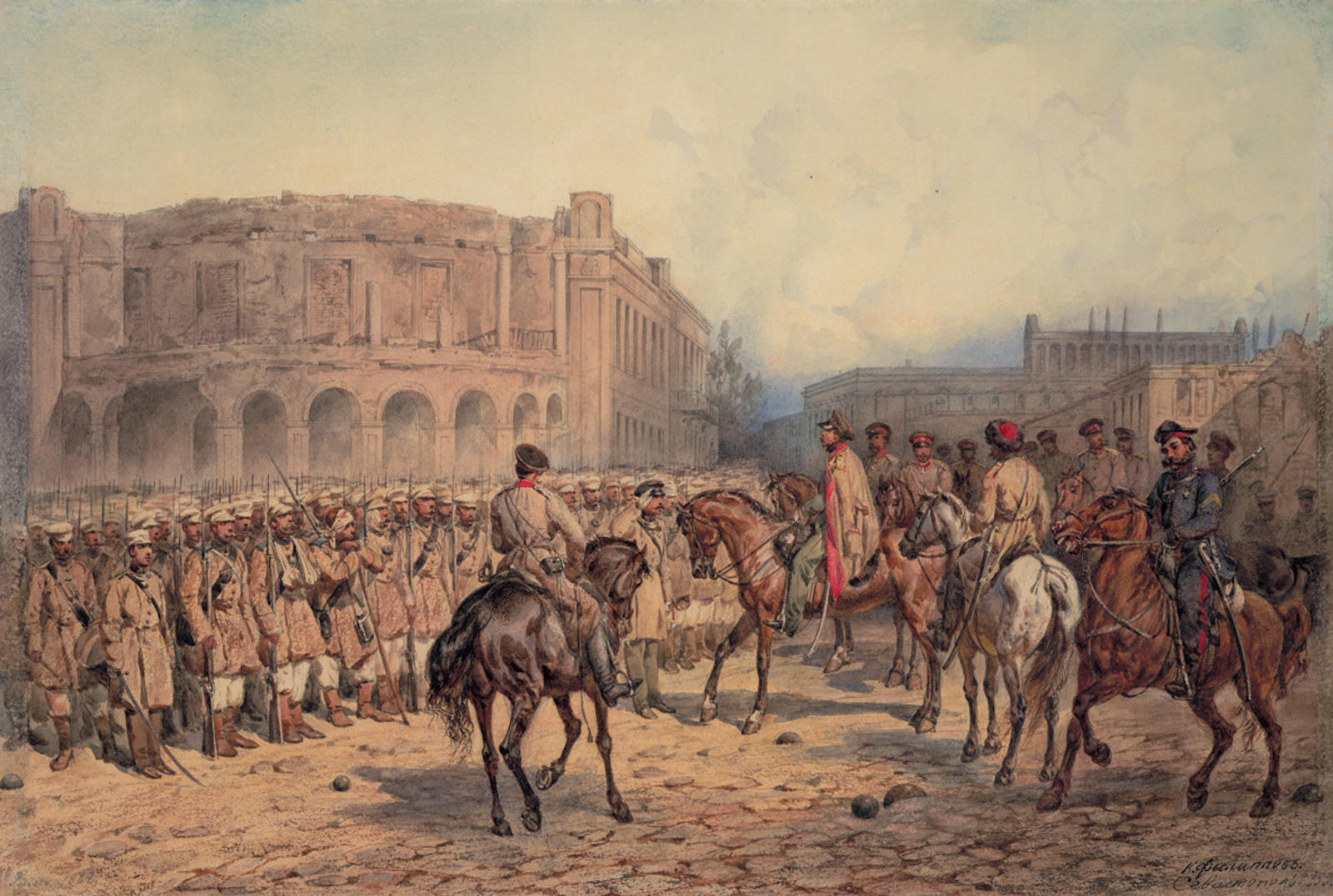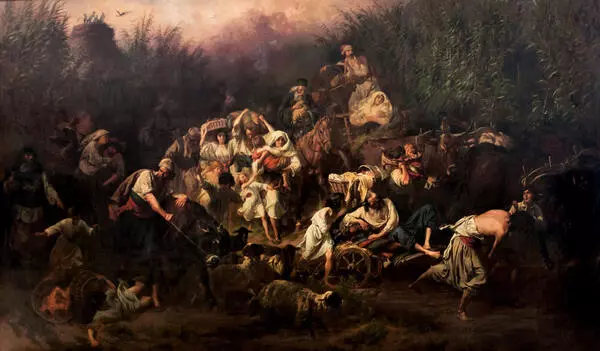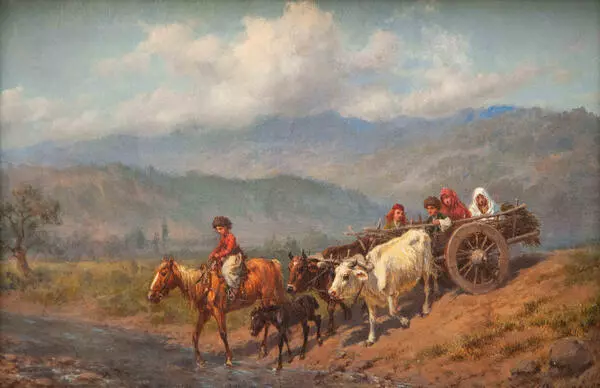The author of the painting Before the Battle is Konstantin Filippov (1830-1878), one of the greatest battle painters of the 19th century and a student of Bogdan Villevalde.
The heroic 349-day long defense of the main naval base of the Russian Black Sea fleet against allied armies of France, United Kingdom, Turkey, and Sardinia in the Crimean War of 1853-1856 started on September 13, 1854. It was in the second month of the city defense that the 26-year-old artillery officer Leo Nikolaevich Tolstoy arrived in the besieged Sevastopol. In his story Sevastopol in December, Tolstoy wrote that ‘a thought that you are in Sevastopol, too, cannot but fill your heart with some courage and pride, and make the blood in your veins flow faster…’ In Sevastopol, the young writer met his close relative and boyhood friend Dmitry Gorchakov.
Konstantin Filippov was sent to the field army as a painter and war correspondent and joined the city defenders at the same time with Tolstoy and Gorchakov. He was one of few people to depict the Crimean campaign in his art. In 1856, he was decorated with a medal For the Defense of Sevastopol. In 1854 through 1858, the artist’s sketches from life were published in the Russian Art Bulletin, and in 1858, his painting completed under the academic program, The Military Road between Sevastopol and Simferopol in the Time of the Crimean War in 1855 earned him the Big Gold Medal and a subsidized trip abroad (the painting is currently deposited in the Tretyakov Gallery).
First, the artist lived in Warsaw and worked on battle compositions commissioned by the Viceroyalty of the Kingdom of Poland, and then he moved to Rome and Paris. In 1864, Filippov took a trip to the Caucasus “with a view to continuing artistic pursuits” under the Viceroyalty of the Caucasus. In 1865, he was granted the title of Academician of Battle Painting for his work The Flight of Bulgarians from the Danube River following the Russian Army Retreat from Silistra. After the end of his subsidized travel period, the artist shared his time between St. Petersburg and Yalta. He put his works on display at the exhibitions organized by the Artists’ Promotion Society and the 1872 Annual International Exhibition in London.
In 1877 through 1878, during the Russo-Turkish war, he served as a battle painter in the Transcaucasia frontlines and special correspondent to the Niva magazine. The last years of his life Filippov spent in the Crimean south coast where he passed away in 1878.
The heroic 349-day long defense of the main naval base of the Russian Black Sea fleet against allied armies of France, United Kingdom, Turkey, and Sardinia in the Crimean War of 1853-1856 started on September 13, 1854. It was in the second month of the city defense that the 26-year-old artillery officer Leo Nikolaevich Tolstoy arrived in the besieged Sevastopol. In his story Sevastopol in December, Tolstoy wrote that ‘a thought that you are in Sevastopol, too, cannot but fill your heart with some courage and pride, and make the blood in your veins flow faster…’ In Sevastopol, the young writer met his close relative and boyhood friend Dmitry Gorchakov.
Konstantin Filippov was sent to the field army as a painter and war correspondent and joined the city defenders at the same time with Tolstoy and Gorchakov. He was one of few people to depict the Crimean campaign in his art. In 1856, he was decorated with a medal For the Defense of Sevastopol. In 1854 through 1858, the artist’s sketches from life were published in the Russian Art Bulletin, and in 1858, his painting completed under the academic program, The Military Road between Sevastopol and Simferopol in the Time of the Crimean War in 1855 earned him the Big Gold Medal and a subsidized trip abroad (the painting is currently deposited in the Tretyakov Gallery).
First, the artist lived in Warsaw and worked on battle compositions commissioned by the Viceroyalty of the Kingdom of Poland, and then he moved to Rome and Paris. In 1864, Filippov took a trip to the Caucasus “with a view to continuing artistic pursuits” under the Viceroyalty of the Caucasus. In 1865, he was granted the title of Academician of Battle Painting for his work The Flight of Bulgarians from the Danube River following the Russian Army Retreat from Silistra. After the end of his subsidized travel period, the artist shared his time between St. Petersburg and Yalta. He put his works on display at the exhibitions organized by the Artists’ Promotion Society and the 1872 Annual International Exhibition in London.
In 1877 through 1878, during the Russo-Turkish war, he served as a battle painter in the Transcaucasia frontlines and special correspondent to the Niva magazine. The last years of his life Filippov spent in the Crimean south coast where he passed away in 1878.





